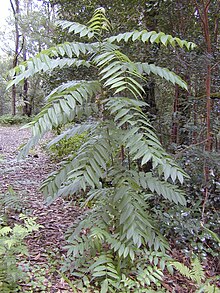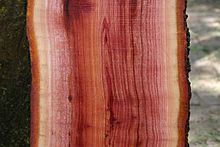User:Junglenut/Toona ciliata
| This is not a Wikipedia article: It is an individual user's work-in-progress page, and may be incomplete and/or unreliable. The current/final version of this article may be located at Toona ciliata now or in the future. Find sources: Google (books · news · scholar · free images · WP refs) · FENS · JSTOR · TWL |
| Junglenut/Toona ciliata | |
|---|---|

| |
| Small specimen of Toona ciliata | |
| Scientific classification | |
| Kingdom: | Plantae |
| Clade: | Tracheophytes |
| Clade: | Angiosperms |
| Clade: | Eudicots |
| Clade: | Rosids |
| Order: | Sapindales |
| Family: | Meliaceae |
| Genus: | Toona |
| Species: | T. ciliata
|
| Binomial name | |
| Toona ciliata M. Roem.[3]
| |
| Synonyms[3] | |
|
List
| |

Toona ciliata, commonly known as red cedar in Australia or Australian red cedar, Indian mahogany, sandal neem or toon tree elsewhere, is a large rainforest tree in the mahogany family native to tropical and subtropical areas of Asia and Oceania. Indigenous Australian names include Polai in the Illawarra, Woolia on the Richmond River, Mamin & Mugurpul near Brisbane, and Woota at Wide Bay.[4] In Timor-Leste it is known as Ai saria,[5] Lal-poma, Poma or Pama in Assamese, and Tun in Bengali and Hindi.[6] It is one of Australia's few native deciduous trees, with the leaves falling in autumn and growing back in spring.[7]
Description
[edit]Toona ciliata is a tall, high-branching tree with a straight bole up to 30–40 m (98–131 ft), with buttress roots up to 3.5 m (11 ft) tall.[7][8][6] The trunk can reach 1.5 m (4 ft 11 in) DBH and has a thick grey or grey-brown bark that is deeply fissured and flaky, resulting in more or less square tessellations.[7][8][6]
The pinnately compound leaves are up to 90 cm (35 in) long, alternately arranged, and crowded towards the ends of the branches.[7][8][6] They may have anywhere from 10 to 30 pairs of leaflets, each of which measure up to 16 cm (6.3 in) by 6 cm (2.4 in), are asymmetric at the base and acuminate at the tip (i.e. forming "drip tips")[7][8][6]
The tree produces masses of white flowers that are very small, white and tubular in shape. The fruits are green capsules which senesces to a brown colour and tear open into star shape to release seeds, which are small and winged.[9]
Distribution and habitat
[edit]In Australia, the tree's natural habitat is coastal subtropical and tropical rainforests of New South Wales and Queensland, much of which has been extensively cleared. The Australian population was formerly treated as a distinct species under the name Toona australis.[10] The southernmost limit of natural distribution is on basaltic soils, growing west of the Princes Highway near the village of Termeil, south of Ulladulla, southern Illawarra, New South Wales.[11] It also occurs naturally at Norfolk Island.[12] The largest recorded T. ciliata tree in Australia grew near Nulla Nulla Creek, west of Kempsey, New South Wales and was felled in 1883.[13]
It grows best in an environment with high light levels, however in the relative darkness of the rainforest understorey, it is less susceptible to attack by the cedar tip moth. The cedar tip moth lays its eggs on the tree's leading shoot, allowing the larvae to burrow into the stem. This causes dieback and a multi-branched tree with little commercial value.[14] The tree exudes a chemical that the female cedar tip moth seeks out. This moth does not attack commercial plantings of Asian/African/Australian native meliaceas in South America. As a result, successful planting of Toona ciliata is being observed in many parts of Brazil, including genetic improvement and clonal production.
Uses
[edit]The timber is red in colour, easy to work and very highly valued. It was used extensively for furniture, wood panelling and construction, including shipbuilding, and was referred to as "red gold" by Australian settlers.[15] Heavily and unsustainably exploited in the 19th and early 20th centuries, almost all the large trees have been cut out and the species is essentially commercially extinct.[16] Availability of this timber is now limited.[17] Timber is currently also harvested in New Guinea.[18] Although it is not generally a viable plantation species, trees are regularly harvested by Forestry in the Atherton region of Queensland.
Other areas
[edit]The red cedar is widely planted in subtropical and tropical parts of the world as a shade tree and for its fast-growing aspect. It is grown in the Hawaiian Islands of the United States, and southern and eastern Africa. In parts of Zimbabwe and South Africa, it has naturalised; growing to maturity and spreading from seed.[19]
Reproduction and dispersal
[edit]Toona ciliata reproduces by seed. It is a prolific seed producer and establishes readily.[20] [21]
Gallery
[edit]-
Capsules and seeds
-
Germinating seeds
-
Seedlings
-
New growth is red
-
Bark, tree near Macksville, New South Wales, Australia
-
Stand of approximately 10 mature trees south of Drake, New South Wales, a rare sighting in this area
-
A stand of Toona ciliata near Kempsey, New South Wales
-
Eight year old plantation trees, Campo Belo, southeast Brazil
-
Four year old, 17 m cloned specimen, Campo Belo, southeast Brazil
-
Large-scale clonal reproduction, Campo Belo, southeast Brazil
See also
[edit]References
[edit]- ^ Barstow, M. (2018). "Toona ciliata". IUCN Red List of Threatened Species. 2018: e.T31332A68105144. doi:10.2305/IUCN.UK.2018-1.RLTS.T31332A68105144.en. Retrieved 7 June 2022.
- ^ "Species profile—Toona ciliata". Queensland Department of Environment and Science. Queensland Government. Retrieved 7 June 2022.
- ^ a b "Toona ciliata". Plants of the World Online. Royal Botanic Gardens, Kew. Retrieved 7 June 2022.
- ^ Cedar & the Cedar Getters - James Jervis. Abridged from the J & Proc. of Roy. Austr. Hist. Soc. 25 (2), 1940. Historical Records of New South Wales, Vol.2, page 283. Forestry Commission of New South Wales
- ^ "Timorese Plant Names and their Origins".
- ^ a b c d e "Toona ciliata". India Biodiversity Portal. Retrieved 6 June 2022.
- ^ a b c d e Mabberley, D.J. (2020). Sandgren, M.; Kodela, P.G. (eds.). "toona ciliata". Flora of Australia. Australian Biological Resources Study, Department of Agriculture, Water and the Environment: Canberra. Retrieved 7 June 2022.
- ^ a b c d "Toona ciliata in Flora of China @ eFloras.org". Flora of China. Missouri Botanical Garden, St. Louis, MO & Harvard University Herbaria, Cambridge, MA. Retrieved 31 May 2022.
- ^ Toona ciliata M.Roem. BioNET-EAFRINET - Keys and Factsheets
- ^ "PlantNET - FloraOnline". plantnet.rbgsyd.nsw.gov.au. Royal Botanic Gardens, Sydney. Retrieved 2021-11-20.
{{cite web}}: CS1 maint: url-status (link) - ^ Eurobodalla Regional Botanic Gardens
- ^ "Red cedar tree in Lindsay Street". Toowoomba Regional Council. Retrieved 2015-01-27.
- ^ "NSW Wilderness Red Index". Archived from the original on 2009-09-30.
- ^ "Australian Red Cedar".
- ^ "Types of Timber". Time 4 Timber. Archived from the original on 2009-01-20. Retrieved 2009-01-21.
- ^ Vader, John. (1987). Red Cedar. The Tree of Australia’s History. Reed: Sydney. ISBN 0-7301-0151-7
- ^ "Red cedar". DAFF. 12 December 2018.
- ^ "PNGTreesKey - Toona ciliata". Guide to the Trees of Papua New Guinea. Retrieved 2009-01-21.
- ^ "Flora of Zimbabwe".
- ^ "Toona ciliata (Toon Tree)". BioNET-EAFRINET. Retrieved January 27, 2015.
- ^ Jagdev Saw Mills
Cite error: A list-defined reference named "GRIN" is not used in the content (see the help page).
External links
[edit]removed inaccurate and unverified statements; updated existing/added new references; expanded centent;
















